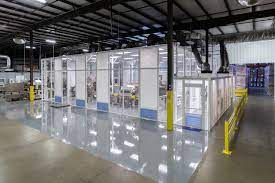A modular cleanroom is a controlled environment that is designed to minimize the presence of airborne particles, contaminants, and other pollutants. It consists of several components that work together to create a controlled and sterile environment. Here are the key components of a modular cleanroom:
-
Wall Systems: Modular cleanrooms are built using specialized wall panels that are designed to provide a clean and airtight enclosure. These panels are typically made of materials such as stainless steel, aluminum, or composite materials. They are easy to assemble, disassemble, and modify according to specific requirements.
-
Ceiling Systems: The ceiling of a modular cleanroom is designed to accommodate lighting fixtures, air vents, and other components. It is usually a grid-based system that allows for easy installation and maintenance of utilities and services.
-
Flooring: The flooring of a cleanroom is an essential component that should be easy to clean and maintain. Common options for cleanroom flooring include epoxy coatings, vinyl tiles, or seamless poured floors. The flooring should be anti-static and resistant to chemicals and abrasion.
-
Doors and Pass-Throughs: Cleanroom doors are designed to minimize particle contamination when entering or exiting the controlled environment. They are typically made of materials such as stainless steel or aluminum with airtight seals. Pass-throughs, also known as airlocks or transfer hatches, allow the transfer of materials or equipment into the cleanroom without compromising its integrity.
-
HVAC Systems: Heating, ventilation, and air conditioning (HVAC) systems are crucial for maintaining the desired air quality and temperature in a cleanroom. These systems control the airflow, filter the incoming air, and maintain the positive or negative pressure required to prevent contamination.
-
Air Filtration: Cleanrooms employ high-efficiency particulate air (HEPA) filters to remove airborne particles and contaminants from the incoming air. These filters capture particles as small as 0.3 microns with a high efficiency of 99.97%.
-
Lighting: Cleanroom lighting fixtures are designed to provide adequate illumination while minimizing the generation of particles. They are typically sealed and made of materials that are easy to clean and maintain.
-
Monitoring and Control Systems: Cleanrooms require sophisticated monitoring and control systems to ensure compliance with cleanliness standards. These systems monitor factors such as temperature, humidity, pressure differentials, particle count, and airflow velocity.
-
Furniture and Fixtures: Cleanroom furniture, such as workbenches, storage cabinets, and chairs, is designed to be cleanroom compatible. These furnishings are made of materials that are easy to clean and minimize the generation of particles.
-
Personal Protective Equipment (PPE): Cleanroom operators and personnel need to wear appropriate PPE to prevent contamination. This includes items such as cleanroom suits, gloves, face masks, and shoe covers.
When it comes to modular cleanrooms in Libya, the above components apply regardless of the location. However, specific regulations and standards may vary, and it is important to ensure compliance with local guidelines and requirements.


No comments yet